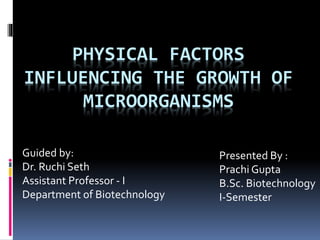
Factors affecting the growth of microbes
- 1. PHYSICAL FACTORS INFLUENCING THE GROWTH OF MICROORGANISMS Guided by: Dr. Ruchi Seth Assistant Professor - I Department of Biotechnology Presented By : Prachi Gupta B.Sc. Biotechnology I-Semester
- 2. Growth An orderly increase in the quantity of all the cellular constituents. The growth of microorganisms is influenced by various physical and chemical factors of their environment. Physical factors- Temperature, pH, osmotic pressure, hydrostatic pressure and radiation. Chemical factors- Oxygen, carbon, nitrogen, phosphorus, sulfur, etc.
- 4. Temperature Temperature is the most important factor that determines the rate of growth, multiplication, survival, and death of all living organisms. High temperatures damage microbes by denaturing enzymes, transport carriers, and other proteins. Microbial membrane are disrupted by temperature extremes. At very low temperatures membranes also solidify and enzymes also do not function properly.
- 5. Types of temperature Minimum growth temperature Optimum growth temperature Maximum growth temperature
- 6. 1. Minimum growth temperature The lowest temperature at which organisms grow is the minimum growth temperature. 2. Optimum growth temperature The temperature at which the most rapid rate of multiplication occurs. 3. Maximum growth temperature The highest temperature at which growth occurs. A temperature only slightly above this point frequently kills the microorganisms by inactivating critical enzymes.
- 7. Classification of bacteria according to growth temperature
- 8. Psychrophiles/cryophiles- 1. The term psychrophile was first used by S. Schmidt-Nelson. 2. Extremophilic organisms that are capable of growth and reproduction in cold temperatures 3. Temperature range: −20°C to +10°C. 4. Examples: Oscillatoria, Chlamydomonas nivalis, Methanogenium, etc.
- 9. Mesophiles- 1. Grows best in moderate temperature. 2. Temperature range: 20°C to 45°C. 3. Examples: Escherichia coli, Streptococcus pneumoniae, etc.
- 10. Psychrotrophs- 1. Cold‐tolerant bacteria. 2. Have optimal and maximal growth temperatures above 15 and 20°C, respectively. 3. Psychrotrophic bacteria and fungi are the principal cause of spoilage of refrigerated food. 4. Examples: Pseudomonas, Aeromonas, Bacillus, Clostridium, etc.
- 11. Thermophiles- 1. Derived from Greek word thermotita meaning heat and philia meaning love. 2. Heat-loving microorganisms. 3. Grow at 50°C or higher. Their growth minimum is usually around 45°C and often optima between 50 and 80°C. 4. Examples: Thermus aquaticus, Geogemma barossii, etc.
- 12. Hyperthermophiles- 1. Thrives in extremely hot environments. 2. Temperature range: 80°C to 113°C. 3. First discovered by Thomas D. Brock in 1965 , in hot springs inYellowstone National Park, Wyoming. 4. The cell membrane contains high levels of saturated fatty acids to retain its shape at high temperatures 5. Examples: Sulfolobus, Methanococcus jannaschii, Thermotoga, etc.
- 13. pH refers to negative logarithm of hydrogen ion concentration. Microbial growth is strongly affected by the pH of the medium. Drastic variations in cytoplasmic pH disrupt the plasma membrane or inhibit the activity of enzymes and membrane transport proteins. pH
- 14. Classification of bacteria according to pH
- 15. Acidophiles- Grow between pH 0 and 5.5. Examples: Ferroplasma, Thiobacillus thioxidans, Sulfolobus acidocaldarius, etc. Alkalophiles- Grow between pH range of 7.5 to 14. Examples:Thermococcus alcaliphilus, etc. Neutrophiles- Grow between pH 5.5 to 8.0 Examples: Lactobacillus acidophillus, E. coli, Pseudomonas aerunginosa, etc. Bacteria prefer media of pH near neutrality, and usually cannot tolerate pH values much below 4-5.
- 16. Osmoticpressure(solutesandwateractivity) Osmotic pressure is the minimum pressure which needs to be applied to a solution to prevent the inward flow of water across a SPM. Types of solution: 1. Hypotonic 2. Isotonic 3. Hypertonic Water activity of a solution is 1/100 the relative humidity of the solution. It is equivalent to the ratio of the vapour pressure of solution to that of pure water. Water activity= Vapour pressure of solution Vapour pressure of pure water
- 17. Classification of bacteria according to osmotic pressure 1. Osmotolerant are those microorganisms which can grow at relatively high salt concentration. Examples: Aeromonas spp., Staphylococcus spp, etc. 2. Halophiles- Grow in the presence of salt at conc. Above 0.2 to 0.6. Examples: Halobacterium halobium
- 18. HydrostaticPressure Force acting per unit area. Classification of bacteria on the basis of hydrostatic pressure Barotolerant – Does not get affected by increased pressure. Barophiles/ Piezophiles- Bacteria which grow at moderately high hydrostatic pressures. Examples: Halomonas salaria, xenophyophores, etc.
- 19. Radiation Sunlight-The major source. Infrared is the major source of Earth’s heat. Ionising rays can produce mutations which may result in death. Visible light is beneficial because it is the source of energy for photosynthesis.
- 20. References Microbiology, P.D. Sharma www.slideshare.net General Microbiology, C.P Powar
